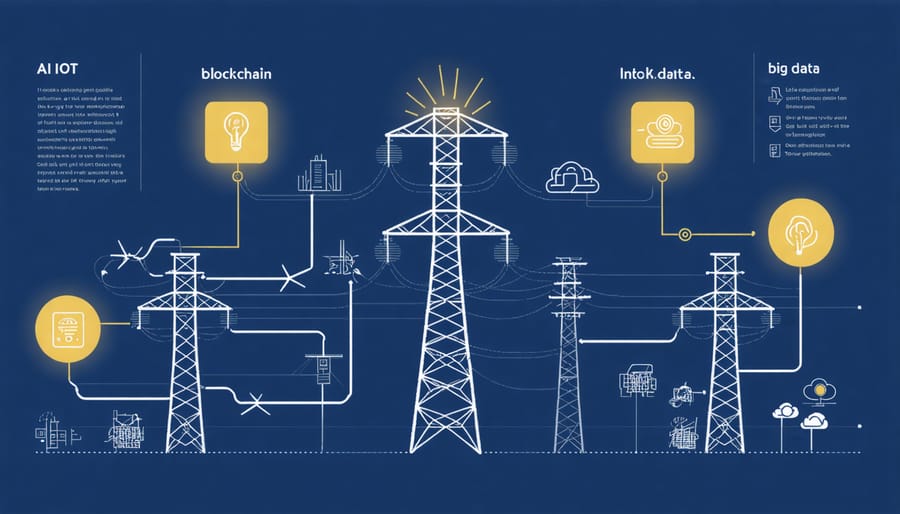5 Game-Changing Renewable Energy Technologies You Need to Know

The renewable energy landscape is evolving rapidly, propelled by groundbreaking technologies that promise to reshape our sustainable future. From next-generation solar cells harnessing the power of the sun with unprecedented efficiency to cutting-edge energy storage solutions enabling round-the-clock clean power, innovation is the driving force behind the green revolution. Smart grid management systems, powered by AI and IoT, are optimizing energy distribution like never before, while green hydrogen emerges as a versatile and clean fuel for industries and transportation. As these technologies mature and scale, they hold the key to accelerating our transition to a low-carbon economy, combating climate change, and securing a greener, more resilient world for generations to come. The future of renewable energy is here, and it’s brimming with exciting possibilities.
Advanced Solar Panels
Perovskite Solar Cells
Perovskite solar cells are a ground-breaking innovation in photovoltaic technology, offering the potential for higher efficiency, lower costs, and greater flexibility compared to traditional silicon-based solar panels. These cells utilize a unique crystalline structure that enables them to absorb light more effectively across a wider spectrum, resulting in enhanced energy conversion. The lightweight and flexible nature of perovskite materials opens up new possibilities for integrating solar power into buildings, vehicles, and even wearable devices. While still in the research and development phase, perovskite solar cells have already achieved remarkable efficiency levels in laboratory settings, with some reaching over 25%. As scientists continue to refine and stabilize these materials, perovskite technology holds immense promise for revolutionizing the solar energy landscape in Europe and beyond, making renewable power more accessible, affordable, and adaptable to diverse applications.


Bifacial and Transparent Panels
Bifacial solar panels, an exciting advancement in photovoltaic technology, are transforming the way we harness the power of the sun. Unlike traditional monofacial panels, bifacial modules capture light on both sides, significantly increasing energy yields by up to 30%. This breakthrough is made possible by using transparent back sheets or glass, allowing light to pass through and reflect off the ground or surrounding surfaces onto the rear side of the panel.
The potential applications for bifacial panels are vast, ranging from ground-mounted solar farms to innovative installations on buildings, carports, and even agricultural land. By leveraging the albedo effect, which refers to the reflectivity of the surface beneath the panels, bifacial systems can optimize energy production in various settings.
Transparent solar panels, another groundbreaking innovation, are opening up new possibilities for integrating solar energy into buildings and infrastructure. These panels use advanced materials, such as perovskites or organic photovoltaics, that selectively absorb light while allowing visible light to pass through. This enables the creation of solar windows, skylights, and even solar-powered greenhouses that generate clean energy without compromising natural lighting or aesthetics.
As these technologies continue to evolve, they are poised to revolutionize the way we integrate solar energy into our built environment. From solar-powered skyscrapers to energy-generating agricultural systems, bifacial and transparent panels are paving the way for a more sustainable and resilient future powered by the sun.
Next-Gen Energy Storage
Solid-State Batteries
Solid-state batteries are revolutionizing solar energy storage, offering a safer, more efficient, and longer-lasting alternative to traditional lithium-ion batteries. By replacing the liquid or gel electrolyte with a solid material, solid-state batteries eliminate the risk of leakage, reduce the fire hazard, and enable higher energy density. This breakthrough technology allows for more compact and lightweight energy storage solutions, making it easier to integrate batteries into solar panel systems for European homeowners and businesses.
The improved stability and performance of solid-state batteries make them ideal for supporting the growth of solar energy across Europe. With higher energy density, these batteries can store more electricity generated by solar panels in a smaller space, reducing the footprint of energy storage systems. Additionally, solid-state batteries have a longer lifespan, which translates to lower replacement costs and more reliable long-term storage for solar power.
As the demand for renewable energy continues to rise in Europe, solid-state batteries are poised to play a crucial role in the transition to a sustainable future. By enhancing the efficiency, safety, and longevity of solar energy storage, this innovative technology empowers European consumers to maximize the benefits of their solar investments and contribute to a greener, more resilient energy landscape.
Thermal and Flow Battery Systems
Thermal energy storage and flow battery systems are emerging as promising solutions for long-duration, scalable renewable energy storage. Thermal storage harnesses heat from sources like concentrated solar power, storing it in molten salts, phase change materials, or other media for later use in generating electricity or providing heat. This technology offers high energy density and efficiency, making it well-suited for large-scale applications. Flow batteries, on the other hand, utilize liquid electrolytes to store energy, allowing for independent scaling of power and capacity. With their long lifetimes, minimal degradation, and ability to store energy for extended periods, flow batteries are gaining traction as a flexible storage option. Innovations in materials and system design are driving down costs and improving performance, positioning these technologies as key enablers of a sustainable energy future. When combined with advanced solar solutions like INOX Solar’s high-efficiency panels and Powerwall storage capacity, thermal storage and flow batteries can help European homeowners, businesses, and industries optimize their renewable energy usage and achieve greater energy independence.

Smart Energy Management
The rapid evolution of technologies like artificial intelligence (AI), Internet of Things (IoT), blockchain, and big data is revolutionizing the way we manage and distribute energy. These innovations are enabling the development of intelligent, decentralized energy systems that optimize efficiency, reliability, and sustainability. Smart grids, for instance, leverage AI algorithms and IoT sensors to monitor and control energy flow in real-time, balancing supply and demand while minimizing waste. This advanced energy management approach not only reduces costs but also enhances grid stability and resiliency.
Moreover, blockchain technology is facilitating peer-to-peer energy trading, allowing individuals and businesses to buy and sell excess renewable energy directly, without intermediaries. This decentralized model empowers prosumers, fosters community engagement, and encourages the adoption of clean energy sources. Big data analytics, on the other hand, is transforming predictive maintenance in the renewable energy sector. By analyzing vast amounts of sensor data, AI-powered systems can detect potential equipment failures before they occur, minimizing downtime and extending asset lifetimes.
As these technologies mature and converge, they are paving the way for a more intelligent, flexible, and sustainable energy future. European homeowners, businesses, and industries can benefit greatly from these advancements, as they enable more efficient energy management, lower costs, and reduced environmental impact. By embracing smart energy solutions, we can accelerate the transition to a cleaner, more resilient energy system that benefits both the planet and the economy.
Green Hydrogen
Green hydrogen, produced through the electrolysis of water using renewable energy sources, is emerging as a promising clean fuel alternative. By harnessing surplus electricity from solar, wind, or hydropower, green hydrogen can be generated with minimal carbon emissions. This versatile energy carrier has the potential to decarbonize various sectors, particularly transportation and energy storage.
In the transportation sector, hydrogen fuel cell vehicles offer a compelling solution for long-distance and heavy-duty applications. With refueling times comparable to conventional vehicles and zero tailpipe emissions, hydrogen-powered cars, trucks, and buses can significantly reduce the carbon footprint of transportation. Moreover, hydrogen can serve as a clean fuel for shipping and aviation, where electrification remains challenging.
Green hydrogen also plays a crucial role in energy storage and grid balancing. Excess renewable energy can be converted into hydrogen, storing it for later use during periods of high demand or low renewable output. This stored hydrogen can then be converted back into electricity using fuel cells or combusted in turbines, providing a dispatchable and low-carbon energy supply. By integrating green hydrogen into the energy mix, Europe can enhance grid flexibility and stability while increasing the share of renewables.
European initiatives are actively promoting the adoption of hydrogen technologies. The European Commission’s Hydrogen Strategy aims to install at least 6 GW of renewable hydrogen electrolyzers by 2024 and 40 GW by 2030. Countries like Germany, France, and the Netherlands have also launched ambitious hydrogen projects and investments. These initiatives not only support the deployment of hydrogen infrastructure but also foster research and innovation in hydrogen production, storage, and end-use applications.
As Europe transitions towards a carbon-neutral future, green hydrogen is poised to play a significant role. By leveraging renewable energy sources, including industrial solar power, to produce clean hydrogen, Europe can accelerate its decarbonization efforts across multiple sectors. With continued investment, policy support, and technological advancements, green hydrogen has the potential to become a key pillar of Europe’s sustainable energy landscape.
Conclusion
The emerging technologies in renewable energy discussed in this article hold immense potential to transform the way we generate, store, and consume clean power. From breakthroughs in solar cell efficiency and durability to advanced energy storage solutions and smart grid management, these innovations are paving the way for a more sustainable and resilient energy future. The development of green hydrogen production and fuel cell technologies further expands the possibilities for clean energy applications across various sectors.
Continued innovation and investment in these cutting-edge technologies are crucial to accelerate the transition to a low-carbon economy. By supporting research, development, and deployment of these solutions, we can unlock their full potential to reduce emissions, enhance energy security, and create new economic opportunities. INOX Solar’s innovations exemplify the commitment to pushing the boundaries of renewable energy technologies and integrating them seamlessly into the European energy landscape.
As a leading provider of comprehensive solar energy solutions, INOX Solar remains dedicated to staying at the forefront of technological advancements. By leveraging these emerging technologies and tailoring them to the unique needs of European homeowners, businesses, and industries, INOX Solar aims to empower its clients to embrace clean energy, reduce their environmental impact, and contribute to a more sustainable future for all.
Leave a Reply